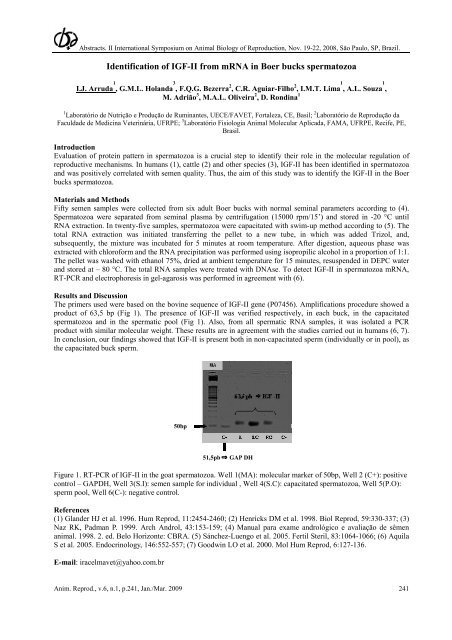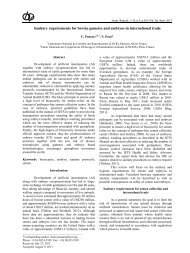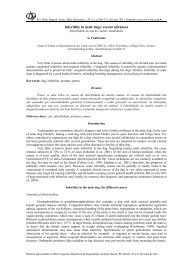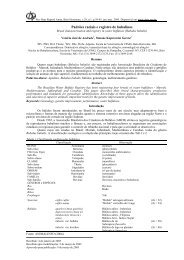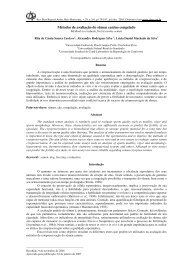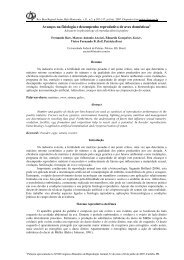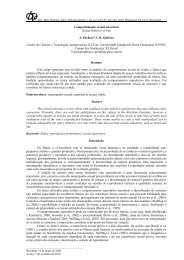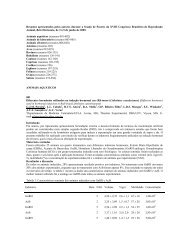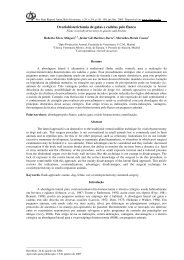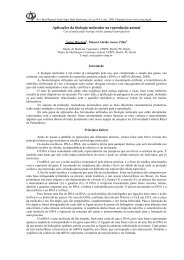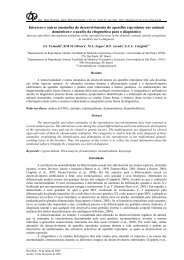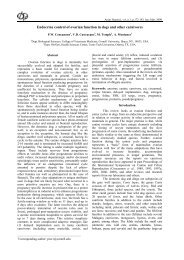Recent advances in ovulation synchronization and superovulation in ...
Recent advances in ovulation synchronization and superovulation in ...
Recent advances in ovulation synchronization and superovulation in ...
You also want an ePaper? Increase the reach of your titles
YUMPU automatically turns print PDFs into web optimized ePapers that Google loves.
Abstracts. II International Symposium on Animal Biology of Reproduction, Nov. 19-22, 2008, São Paulo, SP, Brazil.<br />
Identification of IGF-II from mRNA <strong>in</strong> Boer bucks spermatozoa<br />
I.J. Arruda 1<br />
, G.M.L. Hol<strong>and</strong>a 3<br />
, F.Q.G. Bezerra 2 , C.R. Aguiar-Filho 2 , I.M.T. Lima 1<br />
, A.L. Souza 1<br />
,<br />
M. Adrião 3 , M.A.L. Oliveira 2 , D. Rond<strong>in</strong>a 1<br />
1 Laboratório de Nutrição e Produção de Rum<strong>in</strong>antes, UECE/FAVET, Fortaleza, CE, Basil; 2 Laboratório de Reprodução da<br />
Faculdade de Medic<strong>in</strong>a Veter<strong>in</strong>ária, UFRPE; 3 Laboratório Fisiologia Animal Molecular Aplicada, FAMA, UFRPE, Recife, PE,<br />
Brasil.<br />
Introduction<br />
Evaluation of prote<strong>in</strong> pattern <strong>in</strong> spermatozoa is a crucial step to identify their role <strong>in</strong> the molecular regulation of<br />
reproductive mechanisms. In humans (1), cattle (2) <strong>and</strong> other species (3), IGF-II has been identified <strong>in</strong> spermatozoa<br />
<strong>and</strong> was positively correlated with semen quality. Thus, the aim of this study was to identify the IGF-II <strong>in</strong> the Boer<br />
bucks spermatozoa.<br />
Materials <strong>and</strong> Methods<br />
Fifty semen samples were collected from six adult Boer bucks with normal sem<strong>in</strong>al parameters accord<strong>in</strong>g to (4).<br />
Spermatozoa were separated from sem<strong>in</strong>al plasma by centrifugation (15000 rpm/15’) <strong>and</strong> stored <strong>in</strong> -20 °C until<br />
RNA extraction. In twenty-five samples, spermatozoa were capacitated with swim-up method accord<strong>in</strong>g to (5). The<br />
total RNA extraction was <strong>in</strong>itiated transferr<strong>in</strong>g the pellet to a new tube, <strong>in</strong> which was added Trizol, <strong>and</strong>,<br />
subsequently, the mixture was <strong>in</strong>cubated for 5 m<strong>in</strong>utes at room temperature. After digestion, aqueous phase was<br />
extracted with chloroform <strong>and</strong> the RNA precipitation was performed us<strong>in</strong>g isopropilic alcohol <strong>in</strong> a proportion of 1:1.<br />
The pellet was washed with ethanol 75%, dried at ambient temperature for 15 m<strong>in</strong>utes, resuspended <strong>in</strong> DEPC water<br />
<strong>and</strong> stored at – 80 °C. The total RNA samples were treated with DNAse. To detect IGF-II <strong>in</strong> spermatozoa mRNA,<br />
RT-PCR <strong>and</strong> electrophoresis <strong>in</strong> gel-agarosis was performed <strong>in</strong> agreement with (6).<br />
Results <strong>and</strong> Discussion<br />
The primers used were based on the bov<strong>in</strong>e sequence of IGF-II gene (P07456). Amplifications procedure showed a<br />
product of 63,5 bp (Fig 1). The presence of IGF-II was verified respectively, <strong>in</strong> each buck, <strong>in</strong> the capacitated<br />
spermatozoa <strong>and</strong> <strong>in</strong> the spermatic pool (Fig 1). Also, from all spermatic RNA samples, it was isolated a PCR<br />
product with similar molecular weight. These results are <strong>in</strong> agreement with the studies carried out <strong>in</strong> humans (6, 7).<br />
In conclusion, our f<strong>in</strong>d<strong>in</strong>gs showed that IGF-II is present both <strong>in</strong> non-capacitated sperm (<strong>in</strong>dividually or <strong>in</strong> pool), as<br />
the capacitated buck sperm.<br />
Figure 1. RT-PCR of IGF-II <strong>in</strong> the goat spermatozoa. Well 1(MA): molecular marker of 50bp, Well 2 (C+): positive<br />
control – GAPDH, Well 3(S.I): semen sample for <strong>in</strong>dividual , Well 4(S.C): capacitated spermatozoa, Well 5(P.O):<br />
sperm pool, Well 6(C-): negative control.<br />
References<br />
(1) Gl<strong>and</strong>er HJ et al. 1996. Hum Reprod, 11:2454-2460; (2) Henricks DM et al. 1998. Biol Reprod, 59:330-337; (3)<br />
Naz RK, Padman P. 1999. Arch Androl, 43:153-159; (4) Manual para exame <strong>and</strong>rológico e avaliação de sêmen<br />
animal. 1998. 2. ed. Belo Horizonte: CBRA. (5) Sánchez-Luengo et al. 2005. Fertil Steril, 83:1064-1066; (6) Aquila<br />
S et al. 2005. Endocr<strong>in</strong>ology, 146:552-557; (7) Goodw<strong>in</strong> LO et al. 2000. Mol Hum Reprod, 6:127-136.<br />
E-mail: iracelmavet@yahoo.com.br<br />
50bp<br />
51,5pb GAP DH<br />
Anim. Reprod., v.6, n.1, p.241, Jan./Mar. 2009 241


